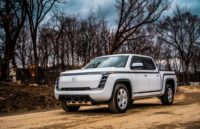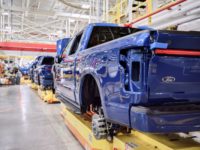Numerous companies are developing electric pickup trucks. But, Atlis Motor Vehicles Inc. thinks it has a better idea than its competitors. The start-up company is developing an EV pickup that features a 500-mile range and a battery that recharges in less than 15 minutes.
The target audience for the XT is commercial users in the agriculture, construction, service and utility industries. The vehicle will meet the size, refueling, towing and payload capabilities of conventional diesel-powered pickup trucks.
The XT will be built on a modular XP platform that will enable Atlis to produce commercial vehicle in other configurations, such as ambulances, delivery vans, firetrucks, step vans or box trucks. The “skateboard” architecture features a drive module that is scalable all the way up to a 10,000-pound capacity per axle without requiring hardware upgrades. Each module contains brake systems, drive systems, suspension and steering systems, which all use drive-by-wire technology. The XP also contains the battery pack and the frame structure.
“Traditional automakers are dependent on their suppliers, sourcing much of the same off-the-shelf-technology as their competitors,” says Mark Hanchett, CEO of Atlis Motor Vehicles. “We are taking a vertically integrated approach, developing all technology in-house to create a vehicle that meets specific customer needs. We innovate with purpose and our strong intellectual property portfolio is a huge differentiator.”
Atlis has applied for numerous U.S. patents, including one that covers battery tabs, terminal position and interlocking cells. “An interlocking terminal design eliminates the need for conductors to be welded between cells to create a completed circuit,” explains Hanchett.
Atlis plans to produce its vehicles at a factory in Mesa, AZ, where it has been setting up automated assembly lines for battery cells and battery packs. Autonomous & Electric Mobility recently asked Hanchett to discuss his company’s unique production philosophy and assembly strategy.
AEM: Why did you decide to build your factory in Arizona?
Hanchett: Because the cost of living is so high in California, many individuals are moving to Arizona, which is attracting a lot of former Silicon Valley technical talent. I’m also originally from Arizona, where I worked for a company called Axon, which is based in Scottsdale. However, I grew up in Traverse City, MI. We plan to set up micro assembly factories around the country. Our long-term goal is to enable customers to configure, buy and deploy a vehicle in their fleet within two days. To be able to do that, we can’t ship every vehicle from Arizona.
AEM: Did you build a new factory or retrofit an existing space?
Hanchett: Our current 43,000-square-foot factory is a rented facility, but there’s space available to double that footprint. However, the next building that we move into by early 2022 will be built from the ground up. It will be about 500,000 square feet and will be full of all the latest automated equipment we need to mass-produce our vehicles. We will have a moving assembly line, but it will combine traditional and new approaches to manufacturing.
AEM: As you ramp up production, what type of tools and equipment are you looking for?
Hanchett: We’re looking for flexibility. If we find a problem, we want to be able to address it and fix it quickly. Our focus is on continuous improvement. Additive manufacturing will be used, especially for more complex components. Long term, we intend to print a lot of basic structural parts. Within a few years, we envision having multiple machines printing things such as control arms and frames. We’re just waiting for the technology to catch up to where we need it to be.
AEM: Why are you making a lot of components in-house instead of purchasing them from suppliers?
Hanchett: We do not work with Tier One suppliers for core technology that we own and produce in-house. Instead, we work with Tier Two and Tier Three suppliers to bring in components that we manufacture ourselves. However, we do have a short-term strategy to work with partners on noncritical systems. For instance, we’re not going to manufacture our own glass, tires, brake pads, rotors or calibers. But, we will be producing motors, gearboxes, battery packs, battery management systems and power electronics in-house.
AEM: What is your production philosophy?
Hanchett: My production philosophy is crawl, walk, run. We want to get products in customers’ hands as early as possible. To do that, we will hand-build vehicles to get started. As we continue to understand where production problems exist as we grow, we will continue to ramp up production. That’s different than the philosophy typically used in the auto industry, where you don’t launch a new product until you can produce at least 50,000 to 100,000 vehicles per year. As a young startup, you have to get product to market to build brand confidence. If you wait for that to happen, it can extend time lines by years.
AEM: What steps are you taking to reduce assembly costs and complexity?
Hanchett: A lot of it depends on simplification of the vehicle architecture. The most expensive thing is the battery pack itself. We are designing our own battery cells, which are being developed to directly integrate within the pack assemblies. We are not buying off-the-shelf cell form factors and then trying to figure out how to make them work in a vehicle application, which is the traditional approach.
To reduce parts count and costs, we have tried to cut the number of wires and connections as much as possible. We also use a lot of common components. For instance, things such as controls for doors, HVAC, lights and seats are built off the same module. They use the same chip, the same basic software platform and the same basic Ethernet-based connectivity. We build it once and then we use it 15 times. That type of philosophy is used to produce every piece of our vehicle.
AEM: As a start-up manufacturer, what are some of the challenges that you’re faced with?
Hanchett: The largest challenge is pushing past tradition. There’s a misbelief that “this is how it’s always been done and therefore this is how it should be done.” We don’t look at things that way. We examine the core of the problem and see if there’s a different approach that is cheaper, faster, better quality or something that differentiates us in the market.






